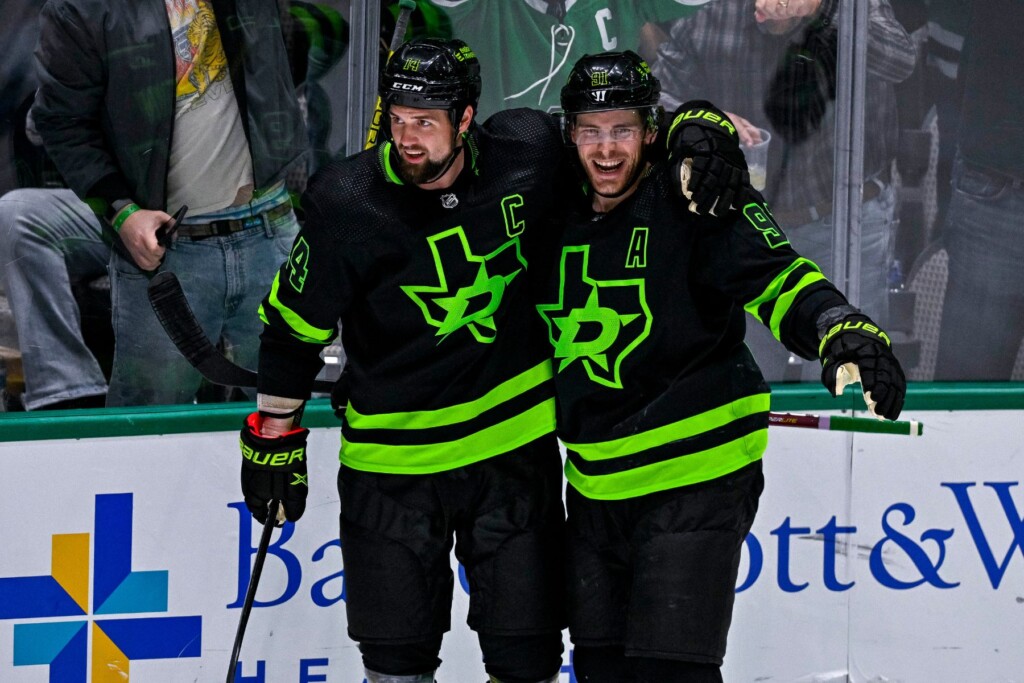It’s easy in Dallas to forget what an aging curve typically looks like. Players such as Joe Pavelski, and Alex Radulov before him, were and are definitely not the norm. Matt Duchene’s resurgence at 33 years old is certainly not the norm.
Traditionally, aging curves look a lot more like what we’ve seen from Jamie Benn and Tyler Seguin over the last six years: two once-dominant players becoming less dominant and all the subterfuge that comes with it. It’s bittersweet for a duo who ushered in one of the most exciting eras of Stars hockey—maybe the most exciting era of Stars hockey—practically on their own. For so long, it was them against the world. But no one can keep up that fight forever.
However, even that curve can have a wrinkle. In this case, two of them: the Bennaissance, followed by the Seguinlightenment. Like a Freaky Friday plot, Benn’s revival now inhabits Seguin, whose recession from last season now inhabits Benn.
As a refresher, Benn’s 78 points last year was the fifth-best mark of his 15-year career and his highest since 2017-18. When adjusted for minutes, his 3.62 points per 60 minutes of play was a career high. And a lot of that damage came on special teams. His shooting percentage on the man advantage last season put him in the top 11 percent of all forwards in the analytics era, and his career-high 30 points on the power play was a big part of what made Dallas into a top-five power play. But it didn’t end there. Benn’s shooting percentage at even strength was also a career high, and 5 percent over the average skater. That’s a lot of averages being bucked, which explains the captain’s current, more human iteration: 2.22 points per hour, which is near his career low. He’s got just nine goals this year, which has him on pace for the least of his career (the old mark originally set during the strike-shortened 2012-13 season).
A funny thing is happening, though. Just as Benn’s resurgence last season was tied to his shooting percentage, the same goes for Seguin’s this season. Right now the 32-year-old is shooting a career-best 18 percent at even strength, resulting in 37 even-strength points that has him above names like Leon Draisaitl and Jason Robertson.
For most fans, this probably isn’t very interesting. Heck, I don’t even find it interesting. They exchanged lucky rabbit’s feet, in other words? Basically. I point it out because I think it’s instructive in the context of what we should expect. Benn was never the player he appeared to be last season, and the same is true of Seguin now. There’s even a grim number highlighting how shooting percentages work: over the past 10 years, the chance of replicating Benn and Seguin’s level of shooting accuracy is 9 percent. Case closed, right?
Yes, actually. Again, this is just the reality of aging and something Stars fans probably take for granted more than most fanbases because their favorite team has so many older players punching above their weight. Benn didn’t just come crashing down to earth this season, either. It was there in last year’s playoffs, when he didn’t score a single goal at even strength. There’s a very good chance that Seguin will be doomed to a similar fate.
However, goals are not how you define performance; they just happen to be the most dramatic examples of it. Benn may be diminished, but what has not diminished is his role in helping Wyatt Johnston (whose line he has recently returned to) become the impact player he’s destined to be. Seguin may look diminished when the goals dry up, but he’ll still be the pivot to Dallas’ most consistent line alongside Duchene and Mason Marchment.
There’s another X-factor, though, and it has no mathematical basis. While Benn and Seguin have never been further apart from who they once were, they’ve also never been closer to a championship together. The Stars are currently fourth in the league and first in the cutthroat Central. They fit the statistical profile for legitimate contenders. This is arguably Dallas’ best roster since Jim Nill became general manager in 2013, and it can withstand any shooting regression from their venerable leaders. That’s what Roope Hintz, Jason Robertson, Joe Pavelski, Miro Heiskanen, Jake Oettinger, and even Duchene are for.
Benn and Seguin won’t have to drink some magical elixir and become Art Ross candidates again to make an impact. They’ll just need a shortened season to recreate some of what they once were—not even a lot, just enough to tilt the ice. If nothing else, they have experience with resurrecting their best selves. As a fight fan, I find a lot of similarities between hockey and prizefighting. Both are a sweet science of physicality and talent. In the ring, just like on the ice, neither sport allows its participants to hide who they are. And Benn and Seguin have given the Stars everything: their dominance and steady decline, their vulnerabilities and stupidities, their humor and renewal.
Well, almost everything. Can they be champions together? They’re only guaranteed one more year on the same roster after next season. Time is running out. So if the Stars do eventually break through and reclaim the Stanley Cup after a quarter century, it may as well be sooner than later. After all, it’s kind of hard to imagine the two faces of this era closing the book on their victory green tenure without standing next to each other, celebrating what they made Stars fans believe in again.
Author







